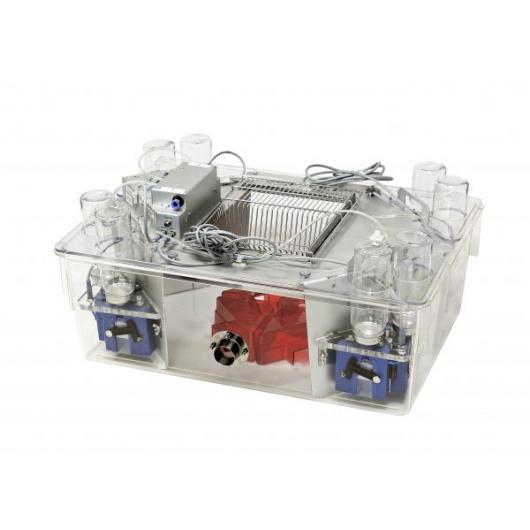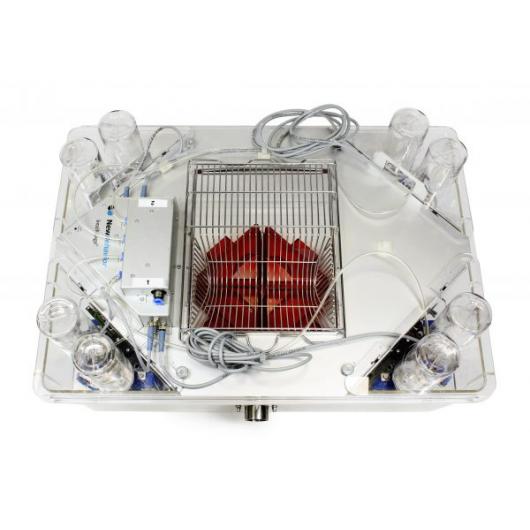




IntelliCage
Features
- In depth screening of individual experimental animals in a social context
- Up to 16 animals per cage, efficient testing, high throughput
- Maximal standardization and reproducibility
- Minimal human intervention, high validity
- Fully automated task performance
- Broad variety of accessible data
- Flexible design of paradigms
Application
- Cognitive Function
- Operant conditioning
Disease models
- Addiction
- Alzheimer´s
- Anxiety
- Autism
- Depression
- Schizophrenia
The IntelliCage, a fully automated system allows you to assess the home cage behavior and cognitive performance of up to 16 individual mice or 8 rats separately while they are living in a social environment. This unique experimental setup fosters natural social behavior in a biologically relevant, enriched but highly standardized home cage context. In this way, the IntelliCage minimizes the need for handling and human intervention, increasing task validity, data reproducibility, and ensuring a high level of animal welfare.
RFID transponder-tagged animals are individually recognized in the fully automated conditioning corners that evaluate spontaneous behavior, operant/associative learning, and memory. The four corners are equipped with sensors (continuous 24h-recording of behavioral events) and actors (allowing the system to feedback on animals’ behavior in a pre-defined way). Together with the software package using a programmable user interface, this unique sensor/actor principle grants direct behavioral shaping of group-housed animals in an all-in-one system according to diverse research interests. The visually designed paradigms run fully automated, allowing for efficient continuous testing and monitoring of large experimental animal cohorts.
To date, IntelliCage data have been published in more than 100 peer-reviewed articles, among them publications in PNAS, Molecular Psychiatry or Nature Communications. The IntelliCage allows a transfer of validated behavioral paradigms into an automated setup, serving as a complement to usual behavioral testing procedures.
Intellicage can be used with several other TSE devices, running wheel, satellite cages, PhenoWorld, connected through Animal gate, which recognizes designated RFID transponder tagged animals to provide access to the respective connected social box.
- Impaired synaptic transmission in dorsal dentate gyrus increases impulsive alcohol seeking
Neuropsychopharmacol. (2022); Nalberczak-Skóra, M., Beroun, A., Skonieczna, E. et al.
- Arc controls alcohol cue relapse by a central amygdala mechanism
Mol Psychiatry (2022); Pagano, R., Salamian, A., Zielinski, J. et al.
- PSD-95 in CA1 Area Regulates Spatial Choice Depending on Age
J Neurosci 2021 Mar 17;41(11):2329-2343. doi: 10.1523/JNEUROSCI.1996-20.2020. Epub 2021 Jan 20.
Anna Cały, Małgorzata A Śliwińska, Magdalena Ziółkowska, Kacper Łukasiewicz, Roberto Pagano, Jakub M Dzik, Katarzyna Kalita, Tytus Bernaś, Michael G Stewart, K Peter Giese, Kasia Radwanska
- Antidepressant treatment is associated with epigenetic alterations of Homer1 promoter in a mouse model of chronic depression. J Affect Disord 2021; 279: 501–509. Sun L, Verkaik-Schakel RN, Biber K, Plösch T, Serchov T.
- IntelliCage as a tool for measuring mouse behavior – 20 years perspective. Kiryk A, Janusz A, Zglinicki B, Turkes E, Knapska E, Konopka W, Lip H-P, Kaczmarek L. Behav Brain Res 2020; 388:112620.
- Lack of APP and APLP2 in GABAergic Forebrain Neurons Impairs Synaptic Plasticity and Cognition. Mehr A, Hick M, Ludewig S, Müller M, Herrmann U, von Engelhardt J, Wolfer DP, Korte M, Müller UK. Cereb Cortex 2020; 30: 4044–4063
- Consistent within-group covariance of septal and temporal hippocampal neurogenesis with behavioral phenotypes for exploration and memory retention across wild and laboratory small rodents. van Dijk RM, Wiget F, Wolfer DP, Slomianka L, Amrein I. Behav Brain Res 2019; 372: 112034.
- Distal infraorbital nerve injury: A model for persistent facial pain in mice. Hardt S, Fischer C, Vogel A, Wilken-Schmitz A, Tegeder I. Pain 2019; 160: 1431–1447.
- Long-term Memory Upscales Volume of Postsynaptic Densities in the Process that Requires Autophosphorylation of αCaMKII. Śliwińska MA, Cały A, Borczyk M, Ziółkowska M, Skonieczna E, Chilimoniuk M, Bernaś T, Giese KP, Radwanska K. Cereb Cortex. 2020 Apr 14;30(4):2573-2585. doi: 10.1093/cercor/bhz261. Erratum in: Cereb Cortex. 2020 May 14;30(5):3429-3430. PMID: 31800021.
- Generation of silent synapses in dentate gyrus correlates with development of alcohol addiction.
Beroun A, Nalberczak-Skóra M, Harda Z, Piechota M, Ziółkowska M, Cały A, Pagano R, Radwanska K. Neuropsychopharmacology. 2018 Sep;43(10):1989-1999. doi: 10.1038/s41386-018-0119-4. Epub 2018 Jun 15. PMID: 29967367; PMCID: PMC6098144.
- PyMICE: APython library for analysis of IntelliCage data.
Dzik JM, Puścian A, Mijakowska Z, Radwanska K, Łęski S. Behav Res Methods. 2018 Apr;50(2):804-815. doi: 10.3758/s13428-017-0907-5. PMID: 28643159; PMCID: PMC5880855.
- Autophosphorylation of αCaMKII affects social interactions in mice.
Harda Z, Dzik JM, Nalberczak-Skóra M, Meyza K, Łukasiewicz K, Łęski S, Radwanska K. Genes Brain Behav. 2018 Jun;17(5):e12457. doi: 10.1111/gbb.12457. Epub 2018 Feb 14. PMID: 29316205.
- Autophosphorylation of alpha isoform of calcium/calmodulin-dependent kinase II regulates alcohol addiction-related behaviors.
Mijakowska Z, Łukasiewicz K, Ziółkowska M, Lipiński M, Trąbczyńska A, Matuszek Ż, Łęski S, Radwanska K. Addict Biol. 2017 Mar;22(2):331-341. doi: 10.1111/adb.12327. Epub 2015 Nov 16. PMID: 26572936.
- Characterization of an alcohol addiction-prone phenotype in mice.
Radwanska K, Kaczmarek L. Addict Biol. 2012 May;17(3):601-12. doi: 10.1111/j.1369-1600.2011.00394.x. Epub 2011 Oct 21. PMID: 22017485.





